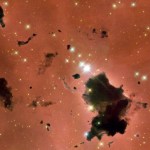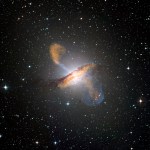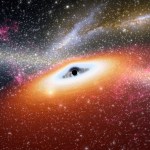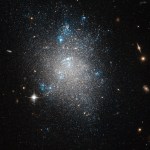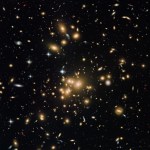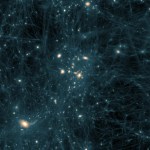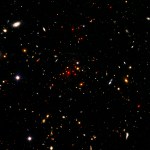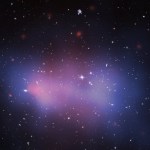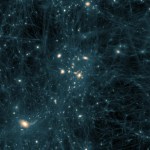Dark Matter
"For me the best answer is not in words but in measurements." -Elena Aprile
If you want to find dark matter directly, your best hope is to gather a tremendous number of nucleons for it to interact with, wait an incredibly long period of time, and devise a device surrounding it capable of detecting even a single potential collision while distinguishing it from any background signals. That was the exact idea behind LUX, the Large Underground Xenon detector.
A diagram of the LUX detector. Image credit: LUX Collaboration, diagram by David Taylor, James White and Carlos Faham.
After a 20…
“The privilege of a lifetime is being who you are.” –Joseph Campbell
Making up some 85% of the mass in our Universe, dark matter is necessary to explain the motions of individual galaxies, the grouping and clustering of assemblies of galaxies, the large-scale structure of the Universe and more. But on a much closer-to-home level, dark matter may be absolutely essential to the origin of life, too!
Image credit: ESO/L. Calçada, of the illustration of the dark matter halo surrounding the luminous disk of our galaxy.
Without dark matter, supernova explosions and starburst events would still…
"The Universe is made mostly of dark matter and dark energy, and we don't know what either of them is." -Saul Perlmutter
When we look out at the Solar System, the Sun dominates in terms of both light and mass. Responsible for nearly 100% of the light and for 99.8% of the mass, it stands to reason that stars would account for the vast majority of mass in the Universe. Yet when we apply what we observe of light and stars to structures like galaxies, clusters, and the large-scale structure of the Universe, not only do stars not get us there, but all the known forms of matter, including gas, dust…
Check out our detailed interview with the famous and amazing Ethan Siegel.
We talk about the history of understanding the universe, why you should believe in Dark Matter even though it is obviously fake, why exploring uranus can lead to the discovery of amazing things, and more.
“If I can't make it through one door, I'll go through another door - or I'll make a door. Something terrific will come no matter how dark the present.” -Rabindranath Tagore
Time continues marching on here at Starts With A Bang, just as it does everywhere. My Patreon supporters have stepped up their game, and we're just $21 shy of unlocking our next goal! There are two great new items this week I'd love to share with you: first, our newest Podcast on dark energy and the fate of the Universe,
and second, a video whose script I helped write (with a bonus coming up) for…
“A single day is enough to make us a little larger or, another time, a little smaller.” -Paul Klee
When it comes to normal matter, dark matter is a bit of a puzzle. Other than through the gravitational force, there's no way we've yet figured out to make it interact. Try and collide it with matter and it passes right through; try and bombard it with energetic particles or radiation and it's completely transparent. But the story is quite different when it comes to dark matter and black holes.
A black hole feeding off of an accretion disk. Image credit: Mark Garlick (University of Warwick).…
“Men occasionally stumble over the truth, but most of them pick themselves up and hurry off as if nothing ever happened.” -Winston Churchill
When we look out at the Universe on the largest scales, from large-scale structure to the fluctuations in the CMB to lensed clusters of galaxies and to giant spirals and ellipticals, we find the same thing everywhere we look: dark matter outmasses normal matter by a 5-to-1 ratio. It's a finding that's independent of direction, scale or distance.
Images credit: X-ray: NASA/ CXC/UVic./A.Mahdavi et al. Optical/Lensing: CFHT/UVic./A.Mahdavi et al. (top left…
“For the moment we might very well can them DUNNOS (for Dark Unknown Nonreflective Nondetectable Objects Somewhere).” -Bill Bryson
The Sun makes up 99.8% the mass of our Solar System, yet stars account for only about 10-20% of the matter that protons, neutrons and electrons make up. Protons, neutrons and electrons -- along with all the other particles known to exist, represented by the Standard Model and what it builds -- make up only about 15% of the observed matter. The remainder must be something different that doesn't interact with electromagnetism or light: dark matter.
Image credit:…
"Eight solid light-years of lead...is the thickness of that metal in which you would need to encase yourself if you wanted to keep from being touched by neutrinos." -Michael Chabon
When it comes to dark matter, the most commonly considered candidates are WIMPs, or Weakly-Interacting Massive Particles. But with the failure of the LHC to turn up anything compelling at the ~100 GeV scale, or any robust hints of a new particle, for that matter, it might be time to consider another possible solution at much higher energies: a heavy, right-handed neutrino.
Image credit: public domain…
"If you take everything we know... it only adds up to 5% of the Universe." -Katie Freese
One of the greatest advances of the 20th century was the discovery of the vast nature of the cosmos: that it was filled with billions of galaxies, each containing billions of stars, and that it extended in all directions for at least tens of billions of light years. Yet when we look out at the full gamut of all there is, the stuff that's normal matter -- made of the same protons, neutrons and electrons that we are -- can account for no more than 5% of the total energy in the Universe.
Image credit: NASA…
"Any fool can criticize, condemn and complain - and most fools do." -Benjamin Franklin
The history of science is rife with stories of cases where a person or team, usually with a lot of clout, reached a conclusion that seemed incontrovertible. When that occurs, we often find that subsequent measurements agree with that conclusion, even if that conclusion later turns out to be wrong.
Recommended speed of light values over time. Adapted from Henrion & Fischhoff (1986).
This was the case for measurements of the speed of light and for the various masses of fundamental and…
"When their eyes grew dim with looking at unrevealing dials and studying uneventful graphs, they could step outside their concrete cells and renew their dull spirits in communion with the giant mechanism they commanded, the silent, sensing instrument in which the smallest packets of energy, the smallest waves of matter, were detected in their headlong, eternal flight across the universe." -James Gunn, on Radio Astronomy
From the time that neutral atoms first formed in the Universe (the creation of the CMB) until the first stars formed, perhaps 100 million years passed. Yet these "dark ages"…
"If you take a galaxy and try to make it bigger, it becomes a cluster of galaxies, not a galaxy. If you try to make it smaller than that, it seems to blow itself apart." -Jeremiah P. Ostriker
13.8 billion years ago, the Universe as we know it was born with no stars, no clusters and no galaxies. But over time, gravitation has built up all sorts of complex structures, with the largest galaxy cluster today, El Gordo, weighing in at 3 quadrillion Suns.
The El Gordo galaxy cluster, imaged by the Hubble Space Telescope and with the dark matter mapped out. Image credit: NASA, ESA, J. Jee (…
"Gamow was fantastic in his ideas. He was right, he was wrong. More often wrong than right. Always interesting; … and when his idea was not wrong it was not only right, it was new." -Edward Teller
Considering what we know about our Universe today, it's hard to believe that just a century ago, Einstein's General Relativity was very much untested and uncertain, and we hadn't even realized that anything at all lie outside our own Milky Way. But over the past ten decades, ten great discoveries have taken place to give us the Universe we understand today.
Image credit: Adam Block/Mount…
"A dwarf standing on the shoulders of a giant may see farther than a giant himself." -Robert Burton
Both the internal motions of individual galaxies and the wholesale motions of galaxies within clusters require much more mass than normal matter — protons, neutrons and electrons — can account for: about five times as much. Because this can't be any of the Standard Model particles, and it can't interact either electromagnetically or with the nuclear forces, we refer to it as dark matter.
Image credit: Wikimedia Commons user Stefania.deluca.
But oddly enough, the smallest galaxies exhibit…
"Few enterprises of great labor or hazard would be undertaken if we had not the power of magnifying the advantages we expect from them." -Samuel Johnson
Dark matter may make up 27% of the Universe's energy density, compared to just 5% of normal (atomic) matter, but in our Solar System, it's notoriously sparse. In particular, there's just a nanogram's worth per cubic kilometer, which makes the fact that we've never directly detected it seem inevitable.
Image credit: J. Cooley, Phys.Dark Univ. 4 (2014) 92-97, via http://inspirehep.net/record/1322880.
But recent work has demonstrated that…
"It may be that ultimately the search for dark matter will turn out to be the most expensive and largest null result experiment since the Michelson-Morley experiment, which failed to detect the ether." -John Moffat
Dark matter is a puzzle that's now more than 80 years old: the presence of all the known, observable, detectable normal matter -- the stuff in the standard model -- cannot account for the gravitation of the astronomical objects we observe. But despite our inability to create or detect it in a laboratory, we're certain of its existence in the Universe.
Image credit: X-ray: NASA/CXC…
“The discrepancy between what was expected and what has been observed has grown over the years, and we’re straining harder and harder to fill the gap.” -Jeremiah P. Ostriker
When it comes to the structure of the Universe -- forming the galaxies, clusters, and Universe as we see it -- the normal matter we know of simply isn't enough. Given our best-understood laws of physics, including Einstein's general relativity, what we see of galaxies and the Universe in general simply doesn't match up to our predictions.
Image credit: NASA, ESA and the HST Frontier Fields team (STScI).
The…
“A cosmic mystery of immense proportions, once seemingly on the verge of solution, has deepened and left astronomers and astrophysicists more baffled than ever. The crux … is that the vast majority of the mass of the universe seems to be missing.” –William J. Broad
When Fritz Zwicky first calculated what the mass of a galaxy cluster needed to be to keep its galaxies moving at the observed speeds and compared it with the masses due to the starlight he saw, there was a huge discrepancy. The amount of gravity in the Universe, when compared to the amount of visible matter, didn't match.…
“All enterprises that are entered into with indiscreet zeal may be pursued with great vigor at first, but are sure to collapse in the end.” -Tacitus
If you want to form a structure like a planet, star or black hole, you need a large amount of mass together in one place. The way to bring that mass together, of course, is through the force of gravity, which attracts everything with mass towards one another in this Universe.
Image credit: ESO/VPHAS+ team, via http://www.eso.org/public/images/eso1403a/.
So why, then, would the greatest source of mass in the Universe -- dark matter -- be…


